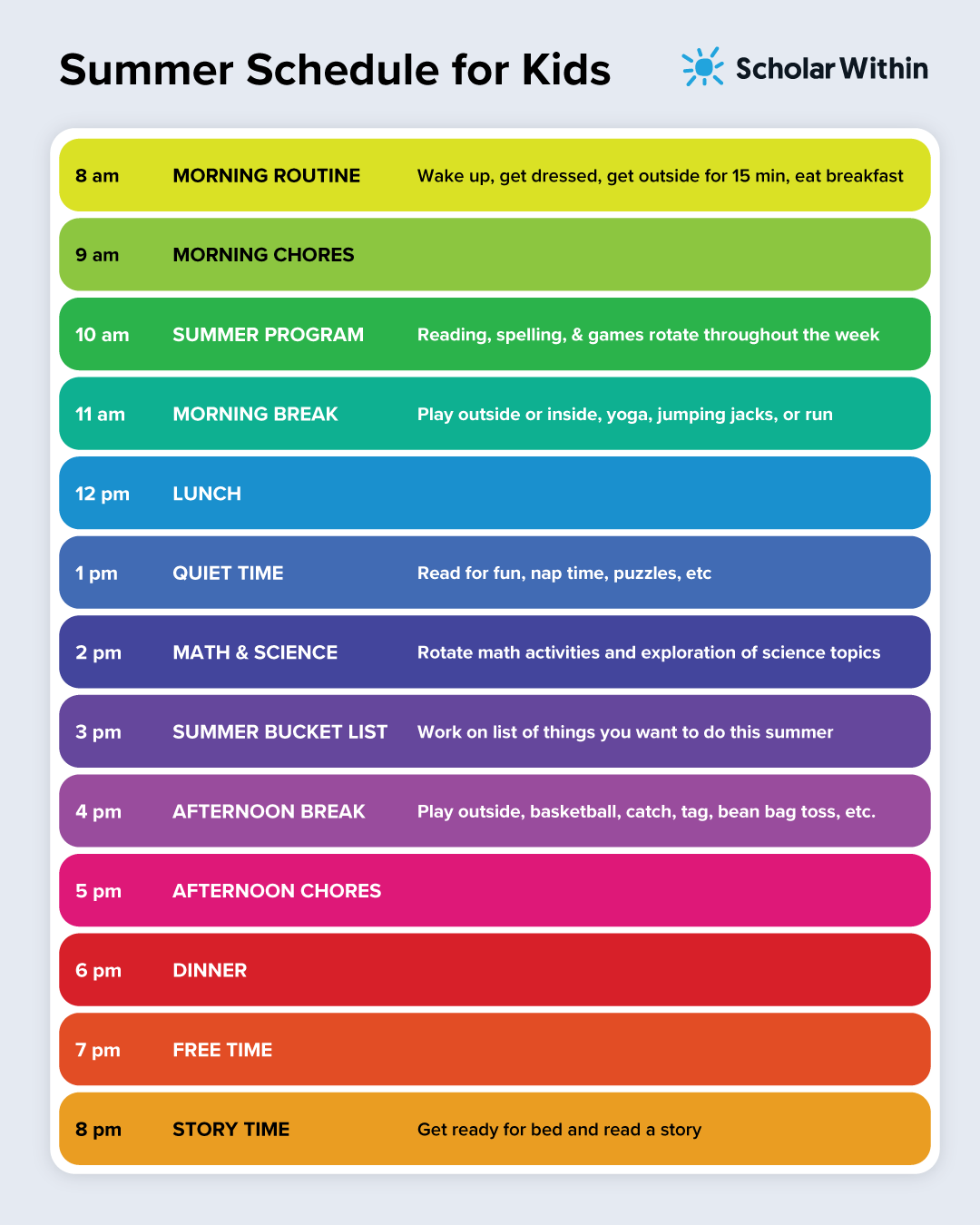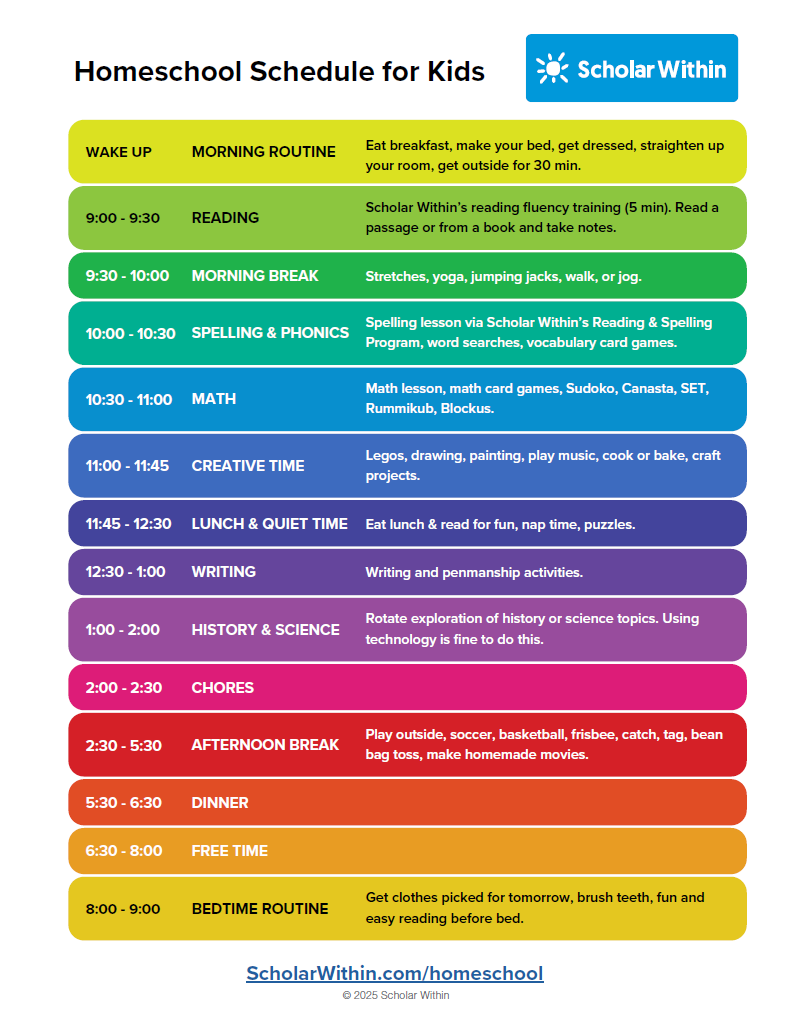
4 Steps to Goal Setting for Kids
Table of Contents
- Overview
- Executive Function Skills and Goal Setting
- SMART Goals (Free Printable Poster)
- 4 Steps to Help Your Kids Set Goals
- Goal Setting Template (Free Printable Worksheet)
- Daily Planner for Students
Overview: How Does Goal Setting Help Kids?
Goal setting for kids is one of the best ways to increase motivation.
Defining, setting, and prioritizing your goals is the first step to helping your child accomplish what they want to do. If they have not clearly defined a goal that they want to accomplish, it is much harder for them to actually achieve it. When your child sets specific goals, it increases their motivation to take the steps to achieve them.
Writing these goals down makes it more concrete than just thinking about them. After writing your goals down, identify what steps you need to take to actualize the goal. This is known as backward design: the process of defining an end goal and then working your way backward to figure out the steps you need to do to achieve the goal.
When you have clearly defined the goal and what steps are needed to accomplish the goal, it is much easier to actually take the steps necessary to attain the goal. When it comes to acting and taking the steps, you already did the thinking behind it, so it is that much easier to act.
- 4 Steps to Successful Goal Setting
- Download the Free SMART Goal Setting Worksheet Printable
- Download FREE Printable SMART Goals Definition Poster
- NEW: Student Daily Planner with Goal Setting, Check-in, and Review
Executive Function Skills and Goal Setting
How do executive function skills relate to goal-setting and planning skills?
Great executive function skills make it much easier to attain your goals. Executive function is the ability to control your own behavior. Are you tempted to have a cookie, but you reach for an apple instead? Those are your executive function skills at work. Executive function includes your ability to control your attention, tune out irrelevant stimuli or information, and think about multiple concepts. It is also your ability to manage your time effectively.
Setting goals and priorities can dramatically help your kids develop their executive function skills.
Executive function skills are learned skills that develop quickly in childhood and teen years, but they keep developing into your mid-20s. With the research on neuroplasticity, we know that our brains are constantly evolving, and you can strengthen these skills no matter your age.
By developing habits of note-taking, writing, and planning, you actively improve your executive function skills. By planning, estimating time, problem-solving, and reviewing, you improve your ability to plan and accomplish your task at hand the next time.
Accomplishing your goals does not innately get better with age. Sure, most adults are often better at their executive function skills, but not everyone grows up to be able to accomplish their goals and what they want in life. Sometimes it is easy to get overwhelmed with everything else that is happening in the world and your life where your goals get put on the back burner.
SMART Goals for Elementary Students
SMART is an acronym to help qualify your child’s goals. For each goal, ask, is it specific, measurable, achievable, relevant, and time-bound?
Download FREE Printable Smart Goals Definition Poster

SMART Goals Definition
Specific
- Simple, Significant, Sensible
Measurable
- Meaningful, Motivating
Achievable
- Attainable, Actionable
Relevant
- Reasonable, Realistic, Results-based
Time-bound
- Time-based, Time-limited
4 Steps to Goal Setting for Kids
1. Write Your Goals Down
The first step is to clearly define what you want to accomplish. Try to make concrete goals that are not vague. The new year is a time that is great to set a big audacious goal that might put you out of your comfort zone, but that is still attainable.
An example of a big audacious goal could be for your child to give a presentation on a topic your child may know something or nothing about to their classroom or another group. Another goal might be for them to learn how to play a song with an instrument.
The goal will depend on the child. If they already excel at something that they want to focus even more on, the big audacious goal would be to push their talents further than what they currently think is possible. Help brainstorm ideas with your child and even come up with an audacious goal of your own this year.
The research from Gail Matthews, a psychology professor at Dominican University of California, shows that the actual process of writing goals down can help improve your chance of accomplishing your goals by 33%.
2. Define the Steps Necessary to Accomplish Your Goals
How are you going to accomplish the goal that you set? This is one of the most important parts of achieving your goal. Write clear detailed steps for what you must do to make progress toward achieving your goal. If your child wants to write a book, some steps might be to write just a sentence every day. Sometimes just writing a sentence can lead to a paragraph. But just planning to do a little bit each day will get you that much closer to realizing your goal.
3. Plan Your Day, Week, and Month
Take out your calendars! Figure out when and where you are currently using your time and figure out where you can schedule a little bit of time each week to work on your goal. Working a little bit every day on something will have a much bigger impact than working one full day every couple of weeks.
Our At-Home and Online Reading Program has the perfect Daily To-Do forms to help you budget your time each day along with weekly and monthly calendars.
4. Review and Reflect
At the end of each week, review what you have done over the week. It is a perfect time to reflect on what you did well, what you struggled with, and what you want to do the next week. By actively reflecting and writing down your successes and struggles, you are able to look at your performance objectively. Make sure to celebrate your successes each week!
It is too easy sometimes to always think about what you need to do to do better, but it is also important to pat yourself on the back for the small wins you have each week. Think about how your life will be different when you accomplish your goal.
Our At-Home and Online Reading Program has the perfect Week-in-Review forms to review and reflect on each week.
Download FREE New Year Goal Setting Template
We put together a school year goal planning template to make the whole process of planning a little bit easier.
In our SMART Goal Setting Worksheet PDF, we start with a big brave goal, move on to another goal that your child needs to accomplish (but might not be something that they are the most excited about), and wrap up with one goal that they’d like to do if there is time to do it.
Download the goal planning template and share it with your friends.
You can decide with your students if they want these goals to be for the rest of the school year or until the end of this year. Sometimes it helps to have a large goal in mind and then to break it up into smaller goals to help you measure progress.
Ask your child what they would like to accomplish in 30 days, 60 days, or 90 days. What will it take to achieve their big audacious goal? Goal setting is not something you do just once a year, it helps to reassess, measure, and evaluate your progress continuously.
Goal setting is a perfect exercise for elementary, middle school, high school, and beyond.
More Goal Setting and Planning Worksheets
A consistent step in actualizing goals is to chart out a calendar with goal milestones. Take a look at Scholar Within’s Daily Planner To-do Notebook. It makes planning, scheduling, and prioritizing as easy as filling in the blanks. It was designed with students in mind, but adults love it too!

Student Daily Planner
- Goal Setting
- Goal Check-in
- Goal Review
- Priority Planning
- To-Do Lists
- Daily Schedule
- Daily To-do
- Daily Planning
- Weekly Planning
- Monthly Planning
- Habit Tracking
- Week in Review
Who is Scholar Within?
Scholar Within was founded by learning expert Bonnie Terry, M. Ed., BCET. Bonnie began designing and developing her custom educational tools when she started her private learning center in the 1990s. Teachers kept asking what she was using with the kids who saw her because of the dramatic improvements that the kids made in school. From there, Bonnie made her materials available to teachers and families worldwide.
Now, Bonnie Terry has turned her materials into a full-service online program that you can follow step-by-step at home, on your schedule. School alone is not enough anymore. Bonnie’s programs boost your kid’s overall learning skills by focusing on improving the auditory, visual, and tactile processing areas of your brain to make it work more efficiently.
Learn more about Scholar Within.




